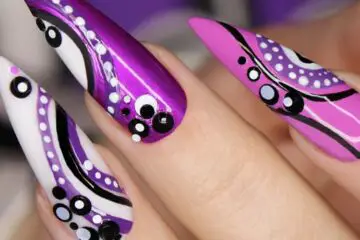Can a nail drill be used on fake nails? | Have you ever been in a situation where your fake nails are looking worse for wear and you just don’t know what to do? Or maybe you’re just curious about the possibilities of nail drills and whether they can be used on artificial nails. Well, let’s find out if a nail drill is the answer to all your fake nail problems! Let’s dive in and explore this question: Can a nail drill be used on fake nails? You may be surprised by what we uncover! So keep reading to learn more.
Can nail drill work on fake nails?
The answer is yes, you can use a nail drill on fake nails! In fact, it’s one of the best ways to clean and shape artificial nails. A nail drill is designed to precisely file down acrylic or gel nails while being gentle enough not to damage them. It uses small rotating bits to trim the length of your fingernails, thin out thick layers, buff away rough spots and refine shapes. Nail drills are great for creating intricate designs too!
When using a nail drill on fake nails, it’s important to use the right type of bit and adjust the speed accordingly. The slower speed settings are best for filing away acrylic or gel because it helps prevent excessive heat build-up which could cause warping or melting of the material. Furthermore, using a dust extractor will help to keep the workspace clean and prevent accidental inhalation of particles.
In addition to shaping and cleaning fake nails, you can also use a nail drill to buff them. A good quality buffer is essential for making sure your nails are smooth and evenly shaped. Using a nail drill with an appropriate buffing attachment will help you achieve beautiful results without damaging the artificial material. Finally, take care not to over-buff as this could cause thinning of the acrylic or gel layers which would make them more prone to breakage.

How to use nail drill on fake nails?
Using a nail drill on fake nails is relatively simple, but there are some important steps to follow in order to achieve the best results.
First and foremost, make sure that your fake nails are properly prepped before you begin. This means that any dirt or debris must be removed from the surface of the nails so that the bit can effectively work its magic. You can use a brush for this purpose or just rinse them off with water. Once you’ve done this, dry the nails completely before moving on.
Next, select an appropriate bit for the job at hand. If you’re using a nail drill with multiple speeds, start at the lowest setting and gradually increase as needed until you achieve desired results. Before you start drilling, be sure to lubricate the bit and the nail surface with a few drops of oil or lotion, as this will help prevent excessive heat buildup.
Once you’ve got your bit in place and the speed is set, begin filing away at the artificial nails according to your desired design. For best results, work slowly and in small sections so that you don’t overdo it on any particular area. Additionally, use a dust extractor if possible; cleaning out debris from time to time can help prevent clogging of the bit and ensure smoother filing action.
Finally, finish up by buffing the nails with an appropriate buffer attachment for a smooth and even finish. And there you have it – a manicure that looks just as good as the real thing!
Does using a nail drill weaken fake nails?
The short answer is no, using a nail drill on fake nails won’t weaken them. In fact, if used correctly, it can help strengthen and shape artificial nails while preserving their natural look and feel.
Make sure that you select the appropriate bit for the job at hand. Different types of bits are optimized for different uses; some are better suited for filing away faux materials such as acrylic or gel while others may be more suitable for buffing or trimming. Choosing the wrong type of bit could cause excessive heat build-up.
Additionally, it’s important to adjust the speed setting accordingly. Lower speeds are recommended for filing away artificial materials, as this helps prevent overheating which can weaken or melt fake nails. Conversely, higher speeds may be more suitable for buffing and shaping because they allow you to work faster without compromising on quality.
When working with a nail drill, lubrication is also key; applying a few drops of oil or lotion before drilling can help reduce friction and heat buildup while preventing clogging of the bit. Furthermore, using a dust extractor will ensure that your workspace is kept clean and free from debris which could lead to blockages or other problems.
Ultimately, using a nail drill on fake nails is perfectly safe as long as you take the necessary precautions. If you follow the proper instructions, tips, and techniques, you’ll be able to create a beautiful manicure with ease – all without compromising on the strength or durability of your faux nails!
What kind of drill do you need for fake nails?
When it comes to choosing the right nail drill for fake nails, there are a few important factors to consider. Firstly, you’ll need to decide on the power and speed settings you’ll require. Most nail drills come with variable speed settings that range from 5,000 to 25,000 RPMs; higher speeds are generally more suitable for buffing, shaping, and polishing while lower speeds are better for filing away faux materials such as acrylic or gel.
Additionally, the type of bit will affect your drilling experience. Nail drill bits come in a variety of shapes and sizes designed specifically for different uses; some are optimized for filing away artificial materials while others may be best used for buffing or trimming. Before investing in a new drill bit set, make sure to research options that offer the specific functions you need for working with fake nails.
How can I shape and shorten my fake nails with a nail drill?
Shaping and shortening your fake nails with a nail drill is relatively easy – all you to do select the appropriate bit, adjust the speed setting accordingly, and start filing away.
For best results use a lower speed setting when filing away artificial materials such as acrylic or gel; this helps prevent heat build-up which can weaken or melt your faux nails. Additionally, applying a few drops of oil before drilling can help reduce friction and ensure smoother filing action.
When trimming down longer sections of the nail, start at one corner and gradually work your way across in small sections; this will help you maintain an even shape while ensuring that no part of the nail is over-filed.
Conclusion | Can a nail drill be used on fake nails?
This article provides information on how to properly use a nail drill for working with fake nails, including tips and techniques such as choosing the right bit and speed setting, lubricating the drill, and filing away excess length.


